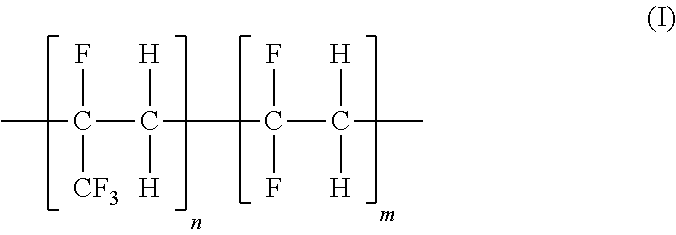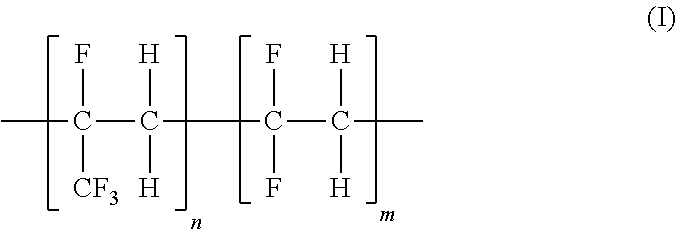Blend polymeric membranes containing fluorinated ethylene-propylene polymers for gas separations
a technology of ethylenepropylene polymer and blend membrane, which is applied in the field of polymeric blend membranes containing fluorinated ethylenepropylene polymers, can solve the problems of complicated and tedious to make such asymmetric integral skinned membranes, and reducing the selectivity of membranes, etc., to achieve low environmental hazard potential, low toxicity, and low corrosion activity
- Summary
- Abstract
- Description
- Claims
- Application Information
AI Technical Summary
Benefits of technology
Problems solved by technology
Method used
Image
Examples
example 1
Synthesis of 2,3,3,3-tetrafluoropropene / vinylidene fluoride Copolymer Comprising about 90 mol % 2,3,3,3-tetrafluoropropene-based Structural Units and About 10 mol % vinylidene fluoride-based Structural Units (Abbreviated as PTFP-PVDF-90-10)
[0036]Into 100 mL of degassed deionized water with stirring, 2.112 g of Na2HPO4.7H2O, 0.574 g of NaH2PO4, and 2.014 g of C7F15CO2NH4 were added. 0.3068 g of (NH4)2S2O8 was added into above aqueous solution with stirring and nitrogen bubbling. The obtained aqueous solution was immediately transferred into an evacuated 300 mL autoclave reactor through a syringe. The reactor was cooled with dry ice while the aqueous solution inside was slowly stirred. When the internal temperature decreased to about 0° C., the transfer of a mixture of 2,3,3,3-tetrafluoropropene (111.3 g) and vinylidene fluoride (11.8 g) was started. At the end of the transfer, the internal temperature was below about −5° C. The dry ice cooling was removed. The autoclave reactor was s...
example 2
Synthesis of 2,3,3,3-tetrafluoropropene / vinylidene fluoride Copolymer Comprising About 64 mol % 2,3,3,3-tetrafluoropropene-based Structural Units and About 36 mol % vinylidene fluoride-based Structural Units (Abbreviated as PTFP-PVDF-64-36)
[0040]Into 100 mL of degassed deionized water with stirring, 2.112 g of Na2HPO4.7H2O, 0.574 g of NaH2PO4, and 2.014 g of C7F15CO2NH4 were added. 0.3018 g of (NH4)2S2O8 was added into above aqueous solution with stirring and nitrogen bubbling. The obtained aqueous solution was immediately transferred into an evacuated 300 mL autoclave reactor through a syringe. The autoclave reactor was cooled with dry ice and the aqueous solution inside was slowly stirred. When the internal temperature decreased to about 0° C., the transfer of a mixture containing 77.1 g of 2,3,3,3-tetrafluoropropene and 32.3 g of vinylidene fluoride into the autoclave reactor was started. At the end of the transfer, the internal temperature was below about −5° C. The dry ice cool...
example 3
Synthesis of 2,3,3,3-tetrafluoropropene / vinylidene fluoride Copolymer Comprising About 22 mol % 2,3,3,3-tetrafluoropropene-based Structural Units and About 78 mol % vinylidene fluoride-based Structural Units (Abbreviated as PTFP-PVDF-22-78)
[0044]Into 100 mL of degassed deionized water with stirring, 2.153 g of Na2HPO4.7H2O, 0.568 g of NaH2PO4, and 2.048 g of C7F15CO2NH4 were added. 0.2598 g of (NH4)2S2O8 was added into above aqueous solution with stirring and nitrogen bubbling. The obtained aqueous solution was immediately transferred into an evacuated 300 mL autoclave reactor through a syringe. The autoclave reactor was cooled with dry ice and the aqueous solution inside was slowly stirred at 50 rpm. When the internal temperature decreased to about −4° C., a mixture containing 47.7 g of 2,3,3,3-tetrafluoropropene and 45.8 g of vinylidene fluoride was transferred into the autoclave reactor. The dry ice cooling was removed. The autoclave reactor was slowly warmed up by air. The aqueo...
PUM
| Property | Measurement | Unit |
|---|---|---|
| mol % | aaaaa | aaaaa |
| mol % | aaaaa | aaaaa |
| mol % | aaaaa | aaaaa |
Abstract
Description
Claims
Application Information
 Login to View More
Login to View More - R&D
- Intellectual Property
- Life Sciences
- Materials
- Tech Scout
- Unparalleled Data Quality
- Higher Quality Content
- 60% Fewer Hallucinations
Browse by: Latest US Patents, China's latest patents, Technical Efficacy Thesaurus, Application Domain, Technology Topic, Popular Technical Reports.
© 2025 PatSnap. All rights reserved.Legal|Privacy policy|Modern Slavery Act Transparency Statement|Sitemap|About US| Contact US: help@patsnap.com


